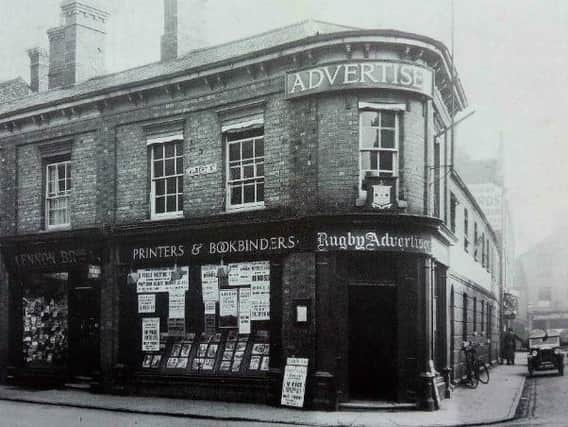Bright lorries and growing anger in New Bilton - former Advertiser reporter remembers Rugby Portland Cement


It was rare to ride the highways and byways of Rugby back in the 1960s without encountering a certain bright orange lorry that came complete with cement mixer on the back still slowly rotating.
I say ‘ride’, because during those roving reporter days, my preferred mode of transport was a Lambretta TV 175 scooter.
Advertisement
Hide AdAdvertisement
Hide AdAnd many’s the time that I quietly cursed being stuck behind one of these lorries, what with dust and cement flakes coming back at you thick and fast.
By now, you’ve surely guessed what I’m talking about. Yes, that’s right – good old Rugby Portland Cement lorries. They were all over the place at one stage, if you remember.
Mind you, I never did understand the orange livery. Perhaps it was the visibility factor, I just don’t know.
During the 1960s, the company was constantly in the Rugby Advertiser’s columns. The paper seemed to be always reporting on dust levels in New Bilton, the residents growing increasingly angry as the decade wore on.
Advertisement
Hide AdAdvertisement
Hide AdAnd they most surely had a point, too. As you approached the area from the Lawfords direction, you could plainly see that the roofs were white with dust, instead of being slate grey.
It’s not hard to imagine how this must have affected the health of residents. The row rumbled on for years and was still going on when I left Rugby for Lancashire in the autumn of 1969.
Rugby Portland Cement was run by Halford Walter Lupton Reddish, an old-style capitalist who didn’t seem to worry too much if his factory was poisoning the air in the New Bilton area.
Educated at Rugby School, he served in the British Army during the First World War. On demobilization he was articled to accountancy. He was also an underwriting member of Lloyd’s.
Advertisement
Hide AdAdvertisement
Hide AdHowever, it was his early association with the cement industry that made him a household name in Rugby. As chairman and chief executive of the
Rugby Portland Cement Company and its subsidiary companies, from 1933 to 1976, he became a spokesman for his chosen industry, especially in the Midlands.
Being an old-style capitalist, Reddish was a firm opponent of nationalisation, then a growing ideology on the Left of British politics. It didn’t do him any harm - he was knighted in 1958.
Despite his short stature, he gave the impression of being a big man, with strong features and heavily reinforced spectacles. He was known to a wide circle of friends as a man of culture, with a lively appreciation of art, and was an accomplished chess player.
Advertisement
Hide AdAdvertisement
Hide AdNevertheless, none of these undoubted attributes stopped him being lampooned by me in the Rugby Rag magazine of 1969. I’ve still got the cutting – and although I definitely thought it amusing at the time, I must confess that the schoolboy humour doesn’t really travel all that well.
Rugby Cement was founded in 1862 as the Rugby Lias Lime & Cement Company Ltd before being renamed the Rugby Portland Cement Company Ltd in 1872.
The business was first started in 1825 as a small family business by two local businessmen, Thomas Walker and his son George, when they started producing lime mortar at a site on their land at New Bilton and nearby Newbold–on-Avon.
In those days, this area was said to have the finest inland section of lower lias limestone in Britain.
Advertisement
Hide AdAdvertisement
Hide AdAround 1870, the company began producing Portland cement, and the company was renamed the Rugby Portland Cement Company Ltd. The next milestone came in 1933, when Reddish was appointed managing director of not just the Rugby operation, but also one at Southam, too.
In the late 1990s, the plant at Rugby was upgraded at a cost of £200 million to a production capacity of 1.8 million tonnes. At the same time the plant at Southam was closed down with production concentrated at Rugby. Reddish died in 1978.
These days, the huge building with its tower looms over not just the surrounding area, but also several Midlands counties. I remember once being surprised that I could see it with the naked eye from as far away as the Cotswolds.
And whenever I climb the Worcestershire Beacon in the Malvern Hills, I always hope for a clear day, as it is then possible to see the building through binoculars.
Advertisement
Hide AdAdvertisement
Hide AdThis provides a fleeting welcome glimpse of the old home town, although some might argue that there could conceivably be more attractive landmarks to be viewed on the horizon.
Anyway, it’s been quite some time since I spotted one of those orange lorries, a sighting which – regardless of where I might be in Britain – always transported me back to Rugby in a split second, to memories of Rugby Portland Cement… and the dust-covered roofs of New Bilton.
John Phillpott has written two books about the Rugby area. Beef Cubes and Burdock refers to his childhood in Churchover and Go and Make the Tea, Boy! is an account of his early days as a reporter on the Rugby Advertiser.